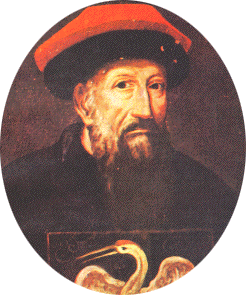Elegant collision between East and West
Johann Adam Schall von Bell
|
|
Before Schall was assigned to the Bureau of Astronomy, he had been invited to the palace by the last Ming emperor and adjusted the tribute piano from Ricci. But it was not long before the Ming Empire collapsed.
When a dynasty was overthrown in ancient China, celestial phenomena were important in foretelling the future ruler of the country. Schall took a chance and offered books on Western calendars to the new Manchu rulers, who adopted both the theories and Schall himself.
Schall became a popular visitor to the palace and talked about science with young Emperor Shunzhi (1638-1661). Though the emperor fell seriously ill and died without accepting Christianity, he did, however, take Schall's advice and named his 8-year old son, Kangxi, his successor.
The little emperor faced challenges to his power from high-ranking officials from the first day he took the throne. Schall was entangled in the struggle and put in jail accused of high treason and false astronomy. He died of old age on August 15, 1666. When Emperor Kangxi finally defeated his rivals and took control of the court, he ordered the wrong done to Schall be righted and his tomb erected near that of Matteo Ricci.
Schall had spent 47 years in China. His trigonometry and many other scientific works were written and published in China. He constructed a double stellar hemisphere to illustrate planetary movement and wrote 150 treatises in Chinese concerning the calendar.
Battle of the heavens
Ferdinand Verbiest was once Schall's assistant. In a dramatic contest in 1669, three years after Schall's death, Verbiest won with his knowledge on astronomy over Chinese astronomers. He also helped Emperor Kangxi strike a blow to his opponents. .
In the contest, the Emperor ordered a public debate concerning the relative merits of Chinese and European astronomy. Two astronomers, the Chinese Yang Guangxian, and the Christian Verbiest would each use their mathematical skills to determine the shadow of a fixed gnomon (sun dial stick). The sky itself would judge.
The privy council, the ministers of state, the officials from Bureau of Astronomy, and a host of other mandarins gathered at the Meridian Gate of the Forbidden City for the contest. Verbiest, with his precise data, triumphed and was immediately named president of the board of Mathematics.
The student and the dancer
One was a student, the other a dancer. Both were great leaders. Emperor Kangxi loved science and studied advanced Western theories diligently, while King Louis XIV loved dancing ballet, earning his nickname the "Sun King" after appearing onstage as the sun god Apollo. Despite the sharp difference in their personalities and hobbies, they shared a common concern about development of science in their respective countries.
King Louis established the France Academy of Science where scientists gathered weekly. Similarly, Emperor Kangxi set up the Institute of Mathematics, and had Western works translated.
But different cultures saw the two countries develop in different ways.
In the traditional and comparatively stable country that China was at the time, it was difficult for foreign ideas and theories to find support. It was only in the late 19th century after major social upheaval and crisis that the Chinese people realized the importance of learning about Western scientific methods.
In his early days, Western astronomy did, in some degree, help Kangxi get rid of the usurping Mandarins who upheld traditional Chinese calendar theories and made continuous mistakes in forecasting some astronomic phenomena. But when his rule had been cemented, the institute's task was to amend the traditional Chinese scientific system, not to further research Western scientific methods.
Historical records show that the Emperor forbade questions concerning astronomy or calendar theories in the imperial examinations late in his reign.
But King Louis left the academy to decide the subjects of their study. The scientists formed their own circles free of the interference of the king. They did not have to pass the king's examinations and no one was going to give orders of what to do next. The free atmosphere provided a vehicle for the rapid scientific development in the country.
An Easterly Breeze over France
 |
|
"The Chinese Fair", tapestry, based on the painting by French artist Francois Boucher. |
 |
|
"The Makeup of the Marquise" by French artist Francois Boucher, circa 1742. The Chinese porcelains, the fan and the screen are clearly seen in the picture |
During many years of mutually beneficial cultural exchange up until the middle of the 18th century, China generally received favorable attention from the west. European missionaries to China took works back to Europe with them, introducing appealing aspects of Chinese culture to Europeans. Chinese artworks became favorites of the European nobility and throughout the 1700s anything Chinese became highly fashionable.



















